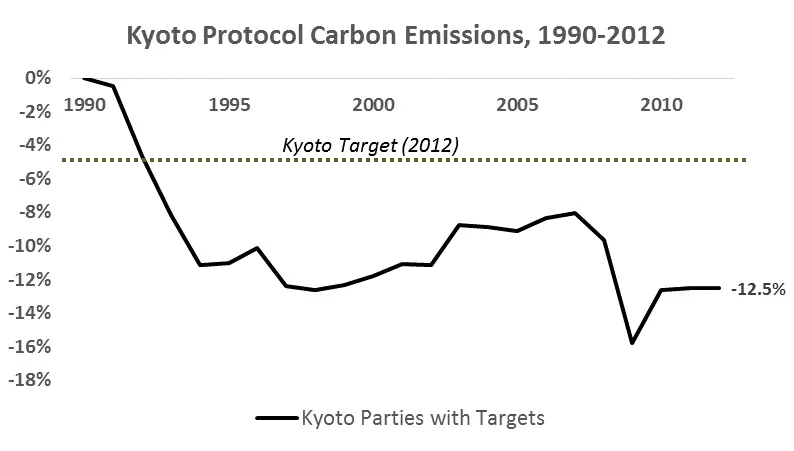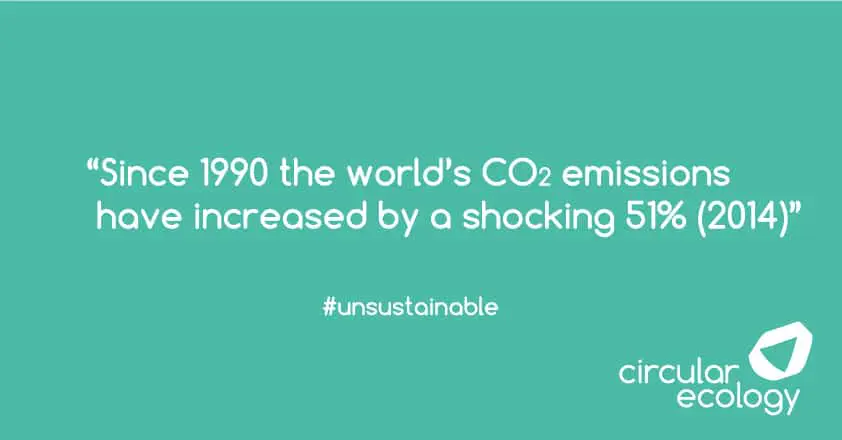Blog, Carbon Footprint, Energy, News, Sustainability
The Kyoto Protocol: Climate Change Success or Global Warming Failure?
In 1997 the Kyoto Protocol was born. It was the first international agreement of its kind, a revelation that would stabilise greenhouse gas concentrations in the climate to “prevent dangerous anthropogenic interference with the climate system”. Flash floods, rising sea levels, record droughts and extreme weather would all to be resigned to the books of history.
So with such an ambitious aim how did the Kyoto Protocol fare and did it go anywhere near far enough to help with sustainability and to fend off global warming?
Let’s take a look…
The headline results tell us that between 1990 and 2012 the original Kyoto Protocol parties reduced their CO2 emissions by 12.5%, which is well beyond the 2012 target of 4.7% (CO2 only, rather than greenhouse gases, and including Canada*). The Kyoto Protocol was therefore a huge success. Well, at least that’s what the politicians will boldly tell us. But does digging deeper reveal the same story?
Let’s start at the beginning.
The Kyoto Protocol was opened for signature in 1998, but it wouldn’t come into force until at least 55 parties ratified the treaty. They also needed to account for at least 55% of the total carbon dioxide emissions of the Annex I countries. This political process took 7 years and it was the ratification of Russia that finally brought the treaty into force in 2005. This was a key landmark in the history of the Kyoto Protocol and the final signature required to bring it into full force. However, only coming to light now is that this was also a political masterstroke that would ensure the success of the Kyoto Protocol before it had even begun. Why so?
The Kyoto Protocol Headline Results
Well, let’s dissect. The carbon emissions from all Kyoto Protocol members are shown in the chart below.
This includes the sum of the regions North America, Europe, Asia Oceania and the ‘Economies in Transition’. The Economies in Transition were mainly composed of central and eastern European countries and include Bulgaria, Croatia, Czech Republic, Estonia, Hungary, Latvia, Lithuania, Poland, Romania, Russian Federation, Slovak Republic, Slovenia and Ukraine.
You may note from the chart just how quickly emissions came down after 1990. In fact by 1994, which was 4 years before the Kyoto Protocol was even open for signatures, members had already reduced emissions by 11.2%. This was already well ahead of the Kyoto Protocol target of 4.7% CO2 reduction by 2012.
A rapid collapse in energy consumption
So why did emissions come down so quickly after 1990?
Well here lies a different and interesting tale. First we need to ask what happened in the early 1990’s that could cause such a rapid decline in carbon emissions. What historical event unfolded?
In December 1991 the Soviet Union (USSR) formally collapsed. In the process it acknowledged the independence of the Republics of the Soviet Union. These newly declared independent states included Ukraine, Uzbekistan, Belarus, Armenia, Azerbaijan, amongst others. At the time little did we know that this would be significant for the Kyoto Protocol.
After the collapse of the Soviet Union there was a rapid decline in heavy manufacturing industries across Russia and the newly independent states. This collapse was particularly significant in Russia and Ukraine, the two largest energy consumers in this group.
The deeper analysis of the Kyoto Protocol shows that this collapse was the key reason for the decline in energy consumption of the Kyoto Protocol parties. This is shown in the chart below.
The results are striking – Without Russia and Ukraine (and without Canada pulling out *) the Kyoto Protocol Parties would only have reduced their emissions by a mere 2.7%. This is well below their target. It is only the fact that carbon emissions reduced in Russia + Ukraine by a combined 32.4% that brings the headline Kyoto Protocol figures down to a 12.5% reduction.
So how does this 12.5% reduction look now?
Not so impressive by far. It is also fitting that the treaty was only ratified into force after the final signature of Russia.
But this still leaves the question ‘was the Kyoto Protocol a climate change success or a global warming failure?’
The Kyoto Protocol: A treaty of limitations
The headline figures make the Kyoto Protocol seem like a huge climate change success and a valuable contribution to environmental sustainability, but the deeper analysis makes it look like a global warming failure.
The reality is that it may well be somewhere in between the two. Sadly, we will never know for sure. We can never know what the emissions of the Kyoto Protocol parties would have been without the treaty. One suspects that most countries didn’t go far enough and this is masked only by the success of a minority. However, it’s acknowledged that without the treaty the greenhouse gas emissions of these countries could have risen more rapidly – we will simply never know for sure.
It therefore appears that for most countries the Kyoto Protocol wasn’t really a treaty of carbon footprint reduction, but instead a treaty of limitation (or perhaps a rather limited treaty?). It was a treaty merely to limit our growth of GHG emissions and a treaty to curb our increasing addiction to fossil fuels.
If we wish to achieve net zero carbon emissions, or carbon neutrality, we still have a long way to go.
Global Warming and Climate Change – Escalating worldwide CO2 emissions
However, what can be stated with certainty is that since 1990 the world’s CO2 emissions have increased by a shocking 51%. Furthermore, a worrying 42% of the world’s CO2 emissions arise from just the USA and China – two countries that didn’t sign up to the Kyoto Protocol.
So this new insight now brings with it a new question – Was the Kyoto Protocol’s biggest failure the inability to sign up the USA and China?
What do you think? We look forward to hearing your thoughts…
If you like this post please consider sharing it on social media using the share buttons or signing up to our Newsletter.
Article Footnotes:
* On the basis of carbon dioxide only (rather than all greenhouse gas emissions) an estimated 4.7% reduction in CO2 emissions is required for the targets to be met. This covers the original Kyoto Protocol parties and therefore includes Canada, who pulled out of the Kyoto Protocol in 2011 when it became clear their target wouldn’t be met.
The full CO2e target was a 5.2% reduction in greenhouse gas emissions, which includes a basket of 6 greenhouse gases, below:
1.Carbon dioxide (CO2)
2.Methane (CH4)
3.Nitrous oxide (N2O)
4.Hydrofluorocarbons (HFCs)
5.Perfluorocarbons (PFCs)
6.Sulphur hexafluoride (SF6)




